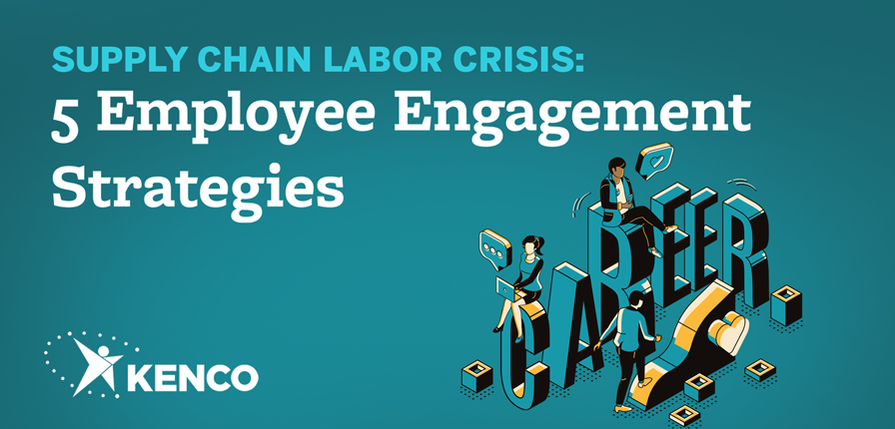It’s no secret that the U.S. is facing a labor crisis across industries, and the supply chain is all but immune. According to the U.S. Bureau of Labor Statistics, 4.3 million Americans, or 2.9% of the entire workforce, quit their jobs in August 2021—a record-breaking month in a string of record-breaking months. The trend has been dubbed as the Great Resignation.
There’s a lot of speculation as to what’s driving this trend. But for employers, a hint might lie in employee engagement. The State of the Global Workforce report found that only about a third (34%) of American employees feel engaged by their jobs.
Engagement is crucial when it comes to finding and retaining labor, and the supply chain faces added challenges in engaging hourly and part-time workers. To keep staff onboard and doing essential work, supply chain employers need to be competitive and creative in making their employees feel valued. Below are five strategies to engage and retain your supply chain workforce amid widespread labor shortages.
1. Ensure Your Supervisors are Good Leaders
The people you work with can make or break a job. Now more than ever, it’s critical to have the right supervisors on your team. There’s no doubt that right now is a high-stress, high-volume time to work in the supply chain, but employers should hold their managers as accountable for creating trust and empathy as they are for setting and achieving performance goals. Employers should look not just for great operators, but for personable leaders who will encourage others and have a desire to move up in the company.
2. Invest in Professional Development
It’s important that employees envision a growth trajectory for themselves at work to avoid feeling stuck and unengaged. A Pew Research Center survey found that 87% of workers believe it will be essential for them to receive training and develop new skills throughout their career in order to keep up with changes in the workplace. If you have a forklift operator with aspirations to become a supervisor one day, for example, you need to ensure you’re equipping them with the right tools to do so. That means providing training and mentorship in communications skills, supervisor skills, technology skills, and more.
3. Commit to Diversity, Equity, and Inclusion
Diversity, equity, and inclusion (DE&I) initiatives are increasingly important to today’s workforce. At Kenco, we’ve found that DE&I matters to people from all walks of life and is a common inquiry in the candidate interview process.
A great way to live these values within an organization is through employee resource groups (ERGs). Various ERGs highlight women, LGBTQ+ individuals, veterans, young professionals, multi-cultural professionals, and more. ERG members play a crucial role in building a community that helps onboard and retain talent. They can also help attract a more diverse pool of candidates, which results in a more vibrant, innovative culture. And don’t forget fun events and professional development opportunities for employees.
When it comes to DE&I initiatives, it is crucial that participation comes from the top down. Supply chain employers should ensure their leadership teams are involved in the pursuit of creating a welcoming, equitable culture in which all voices are heard. By investing in employees in this way, organizations create engaged advocates for their workforce.
4. Get Creative and Competitive with Benefits and Compensation
Employees want to be a part of companies that support their physical health, mental health, and pursuit of meaningful personal endeavors. Many are even willing to compromise on salary for more holistic benefits packages that include paid volunteer time, wellness programs, strong medical benefits, competitive PTO packages, and more.
Half of workers above 55 think competitive pay and benefits are crucial to their engagement, according to an IBM Institute for Business Value survey. That means employers should look into both monetary and non-monetary benefits for their workers to make them feel valued both on and off the clock. At Kenco, for example, we’re piloting shift swapping and flexible schedule arrangements so that we can accommodate the scheduling needs of diverse employees—from students to working parents to caretakers. It will be important for all supply chain employers to embrace this kind of flexibility and proactively seek ways to bring value to company culture. These offerings will help immensely in both attracting and retaining talent.
5. Turn Employee Engagement into a Science
Surveys are a great tool to collect and analyze data to find areas for improvement. At Kenco, we execute Gallup’s Q12 Employee Engagement Survey annually to get a sense of our employees’ needs and job satisfaction. With the survey’s findings, we create scorecards and dashboards with key findings and ensure they get executive visibility. From there, respective sites are able to create and implement purpose-driven action plans for continuous improvement. We’ve found that using data and processes are a great way to deliver people-first improvement.
Key Takeaways
Attracting and retaining employees amid labor shortages presents the supply chain industry and employers across all industries with an interesting challenge – balancing creating value and reducing costs for employees while managing their own costs. It’s a puzzle with imperfect pieces and one that requires creativity and flexibility, but employers need to invest in engagement to stay competitive and relevant. If there’s one common theme in all of these suggestions, it’s that employees want to feel valued, heard, and—dare we say—have fun at work. These strategies are a few of many ways to help make that happen.

